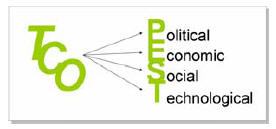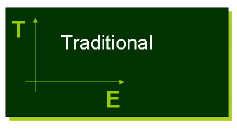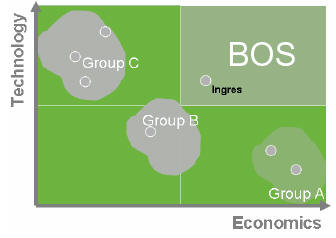
"It
is impossible for ideas to compete in the marketplace if no forum for
��their presentation is provided or available."�������� ��Thomas Mann, 1896
Total Cost of Ownership in the Open
Source Database Community
Contributed by
Ingres
- Business
Open Source
Author:� Chris Twyman
�
�
Introduction
-
The total cost of adopting new technology is much greater than the trade off between the economics and the function of that technology.
-
As the drive towards open source business models continues TCO needs to embrace the demands of that growing community.
-
For effective and long term cost reduction a broader perspective of TCO needs to be considered.
-
Software choice has both an impact on both the corporation and the individual.
-
The Open Source business model enables both the corporation and the individual to grow and prosper.
TCO a broader perspective
Traditionally Total Cost of Ownership (TCO) studies carried out in the technology space have been very focused on the economics of adopting new technology.
Using the PEST* model (Political, Economic, Technological and Social) as a broader perspective on TCO poses some interesting questions. Not only the corporation’s motives for purchasing new technology but also the individuals motives within that corporation will impact TCO

* PEST analysis is traditionally used to model the macro-environment.
First to be considered in any Cost Benefit Analysis (CBA) or TCO study is the economic impact of that project. Traditional software deals involve four key economic factors. License and support costs are usually fixed and easier to predict. Skills and Migration costs are not linear and will vary widely dependant on the nature and predictability of the project.
The flip side of TCO is the benefit the project offers to the firm. The project must scale with minimal incremental economic costs. A reliable project will reduce the ongoing skills costs. Finally, a crucial consideration for any software choice must be that the project will be flexible enough to evolve with the changing needs of the firm. Managing these three technological characteristics will help reduce TCO in the long term.
Both economic and technological considerations really impact the firm. The next two factors, political and social, are much more focused on the individual who is making the decision to initiate a new project within the firm.
From a political perspective the individual will feel pressure from three areas. The first is from his colleagues; any new project involves change, there must be a willingness to accept the change or the cost of the that change will invariable rise over time. Change can be imposed by legislation which is a cost the firm needs to bear and will raise TCO. Finally, the individual decision maker will always feel pressure from the incumbent supplier of software to stick with "what they know best".
Social aspects have a significant impact on TCO and choosing new technology. How will this project make the individuals life easier? Manageability, the user group size and potential in terms of career growth will all be taken into consideration.
In conclusion any TCO study must consider not only the firms, or the corporate aspirations, for the project but also the benefit at an individual level.
TCO decision making.

Each of the PEST factors alone tell a separate story in the decision making process for any new project. But the individual/s who make the decision to move forward with a new technology choice will not make that decision in isolation.
If we plot the PEST factors against on another a more realistic decision making process can be explored with some interesting conclusions.

The trade off between the level of functionality and the cost of that choice.
"You get what you pay for." This trade off is the traditional cannon fodder for any standard TCO study. Is it is a crucial starting point, and only a starting point, for any new initiative.
Enhanced functional richness can lead to an easier life and a more productive future
Functionally rich technology will reduce training costs and increase the individual’s motivation to use and expand its use. The individual will also recommend the technology’s use to others.
Purchasing technology must have commercial, as well as individual benefits
The individual will balance the economic benefit to the firm with how that choice will make their life easier. Large user communities for any technology will provide the safety net for that decision.
As the technology footprint inside an organization grows so does inertia to change.
Migration costs can be a significant barrier to entry for new, and a potentially more exciting technology. "No-one got fired for an IBM project that goes wrong" is the safe zone for many individual decision makers who are risk adverse.
Organizations will make a trade off between change and cost of change unless regulation enforces that process.
Regulatory initiatives like Sarbanes Oxley and the Patriot Act, although worthy initiatives, will increase TCO for the firm. In isolation of that legislation firms will only change is the economics make sense.
Choosing an incumbent supplier will make life easier, if not safer.
A previously discussed choosing an incumbent supplier will be the safer option for job security. Unfortunately that overlooks the potential process benefits of exciting new technology that is a riskier proposition.
TCO and the impact of Open Source Technology.
The Open Source business model is changing TCO decision making radically. There will always be a balance however. Eliminating some of the economic factors will increase the individual’s risk of adopting new technology.
Traditional
Little or no License cost provide a incentive to adopt new open source technologies. This is providing that the technology is as good or better than the incumbent and the migration costs are low enough to keep the economics attractive.
Personal
Adopters of open source technology have the opportunity to significantly influence the direction of the product. At an individual level there is little or no opportunity to do this with traditional software vendors. This fact alone makes the open source model very attractive for individuals.
Corporate Citizen
In making a decision to adopt any new technology the size and reference ability of the user community will reduce the risk to the individual decision maker and protect the economic choices of the firm. Open source vendors must focus on building the individual community so that firms recognize the reduction in risk.
Vendor Pressure
There will be a ‘tipping point' for any new technology vendor. It is at this point that the adoption of that product accelerates. Open source vendors can reach that tipping point quicker if they can provide migration processes and solutions that are market friendly (economically, technologically, socially and politically).
Cost Pressure
Firms are making policy decisions about open source technology strategies. Government and Not-for-Profit organizations, in particular, are all embracing this business model. Successful TCO case studies, if they incorporate regulatory projects, from these early adopters will spring board more wide spread open source strategies.
Job Preservation
Individuals make decisions; not corporations. Open source technology must be a viable option in all PEST factors, or self preservation will always prevail.
TCO and the impact of Open Source Database Technology.
Using the Traditional category (outlined previously) we can create a spatial chart for TCO decision making in the relational database market. The top right hand quadrant of is what all database consumers would like to call and ideal open source environment - a technology rich product at low / zero cost. The assumption is then that decision makers will ultimately demand vendors to occupy this space in the chart. Computer Associates defines this quadrant as Business Open Source BOS. In this quadrant firms can benefit from significant Economic TCO benefits without compromising on the richness of that technology.
If we then plot the key database vendors on this chart, three groupings appear:
Group A
Here the current open source database market emerges with a few emerging vendors. The characteristics of group A is that economics might be very attractive (good for open source), but the technology invariable does not scale very well (bad in an enterprise environment).
Group C
The opposite extreme to group A is group C. Here the industry gorillas flex their technical superiority but make their customers pay for it, in terms of license costs.
Group B
Lying in between is group B. The market perception of these operators is mid range quality and mid range price. In some circumstances these products will be taken seriously in an enterprise environment, at other times they will not.
Traditional decision factors for the relational database market:
As previously stated the assumption is that the market will demand players to move towards the enterprise open source quadrant on the chart. Which group is best placed to make that move?

Start with group C. Any move towards the enterprise open source quadrant would see a serious loss of revenue. Most of the players in this group have a relational database as their flagship product, with no other substitute revenues. Any significant move towards the BOS quadrant would be corporate suicide.
Group A has an even bigger problem to overcome than group C in order to make it into the BOS quadrant. In order to meet enterprise requirements group A must make significant investment in their product. With little or no product revenues the chance of doing this is very optimistic.
That leaves group B. Companies here have large and diverse product portfolios. Although the database is a cornerstone, it is not critical to the success of these players. These companies have deep pockets and large, global footprints and the ability of move up the technology axis and along the economics axis without seriously affecting their business operations.
Computer Associates is a member of group B and ingres r3 has entered the BCOS quadrant as the first enterprise relational database to adopt and open source license structure.
"The relational database world is evolving. Enterprise customers are demanding rich, functional products that scale, whilst lowering the total cost of ownership. Ingres is the first, enterprise, relational database that has embraced the open source license model. It has the pedigree of one of the most seasoned and functional products in the market that can be flexible enough to meet the demands of even the largest organizations."
Tony Gaughan SVP Computer Associates
Disclaimer

 Search Our Site
Search Our Site
Search the ENTIRE Business
Forum site.�Search includes the Business
Forum Library, The Business Forum Journal and the Calendar Pages.
The Business Forum, its Officers, partners, and all other
parties with which it deals, or is associated with, accept
absolutely no responsibility whatsoever, nor any liability,
for what is published on this web site.��� Please refer to:
Home���
Calendar��� The�Business�Forum�Journal����
Features���
Concept���
History
Library�� �
Formats���
Guest�Testimonials���
Client�Testimonials���
Experts��� Search
News�Wire���� Join���
Why�Sponsor����
Tell-A-Friend����
Contact The Business Forum
The Business Forum
Email:�
[email protected]
� Copyright The Business Forum Institute 1982 - 2012� All rights reserved.
Graphics by
DawsonDesign
Webmaster:�
bruceclay.com
![]()
�
�




